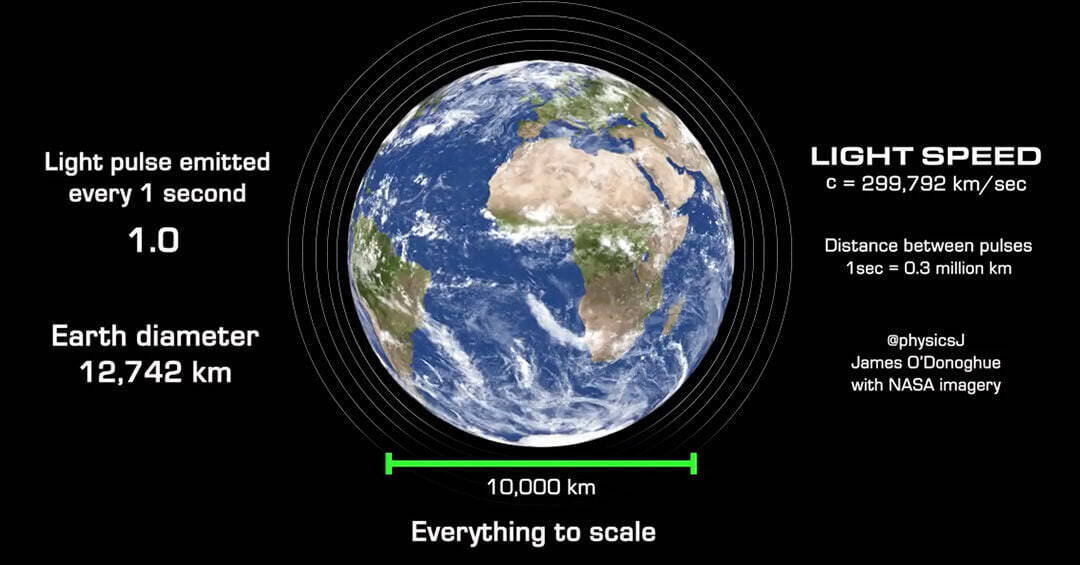
Solar system
Humanity has always been fascinated by space travel and the exploration of distant planets. Throughout history, even ancient civilizations created telescopes and studied the night sky in search of answers about the universe. They used the stars as navigational tools and looked for divine beings among them.
As humanity progressed, its knowledge of the cosmos expanded, and the fascination with space only grew stronger. After successfully landing on the Moon, the next logical step was to explore Mars, the planet closest to Earth in many aspects. With advancements in technology, from horse-drawn carriages to the invention of the Large Hadron Collider, people have started seriously considering the possibility of colonizing other planets within the past 150 years.
What are the Reasons to Travel to Mars?
Mars, also known as the Red Planet, is a fascinating destination for scientific exploration. The primary objectives of a mission to Mars include the search for extraterrestrial life, gaining a deeper understanding of the planet and its history, preparing for future colonization, and advancing technological development.
Exploring the possibility of life beyond Earth is a fundamental question that has intrigued humanity for centuries. Mars is particularly intriguing because it bears similarities to our own planet, making it an ideal starting point for the search.
Studying the geology of Mars firsthand will provide valuable insights into the planet’s history. While Earth was undergoing its own geological transformations, Mars was experiencing major climate changes and cataclysmic events. By comprehending the complexities of Mars, we can enhance our understanding of Earth and its evolution.
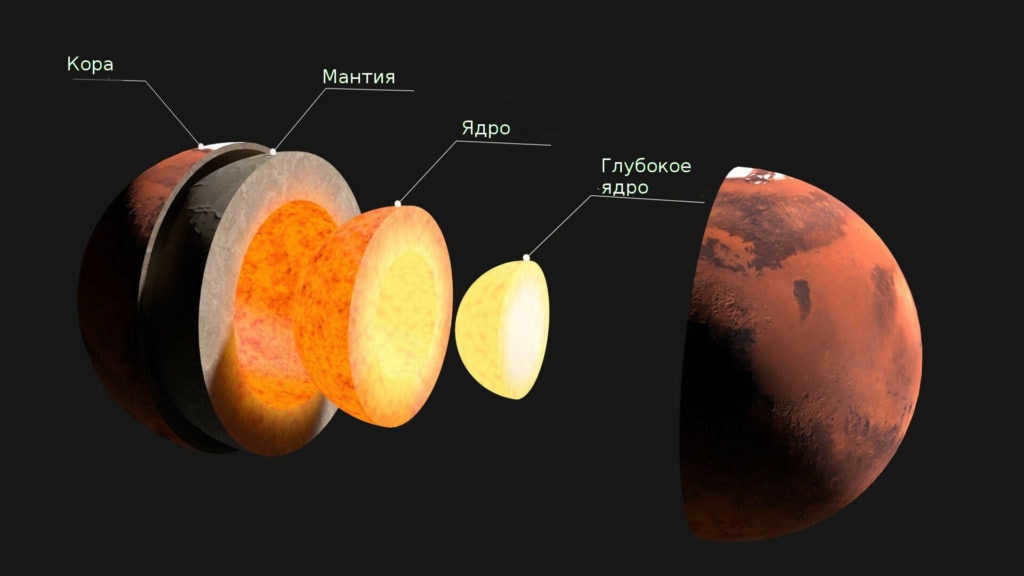
Exploring the planet Mars will offer valuable insights into the impact of space travel and interplanetary journeys on the human body. This endeavor is set to become a significant milestone in the annals of human civilization.
What is the travel time for light to reach Mars?
The distance between Mars and Earth is constantly changing as the planets orbit the Sun. This means that the amount of time it takes for light to travel from a specific point on Earth to Mars will vary.
To understand how long it takes for light to reach Mars from Earth, we need to consider the varying distances between the two planets. The distance can range from 55 to 400 million km. When the planets are at their closest, it takes approximately 3 minutes for light, which travels at a speed of 299,792 km/s, to reach Mars. However, when they are at their farthest, it takes around 22 minutes for light to reach the planet.
On the other hand, the distance between Mars and the Sun is approximately 227,990,000 km. It takes about 12 minutes and 40 seconds for light from the Sun to reach Mars.
Despite the fact that no human has ever stepped foot on Mars, scientists have maintained a longstanding interest in the planet and have been sending various devices and vehicles since 1964 to conduct more detailed studies of the Red Planet.
The initial Mars exploration mission was carried out in 1964, when the United States dispatched a vehicle called Mariner-4 to orbit the distant planet. The spacecraft traveled for 228 days, providing scientists with 21 photographs.
In 1969, Mariner-6 was launched to Mars. This mission, which lasted for 155 days, focused on orbiting the Red Planet and gathering atmospheric and surface temperature data.
In the same year, Mariner-7 was also dispatched as a backup. Its journey spanned 128 days.
The Mariner-9 spacecraft was launched in 1971 and it took 168 days to reach Mars. This period of time made it the first artificial satellite of the planet. During its relatively short lifespan (until October 1972), Mariner-9 successfully mapped the surface of Mars.
Viking-1, on the other hand, was the first spacecraft specifically designed to land on the Martian surface. It completed its journey in 304 days.
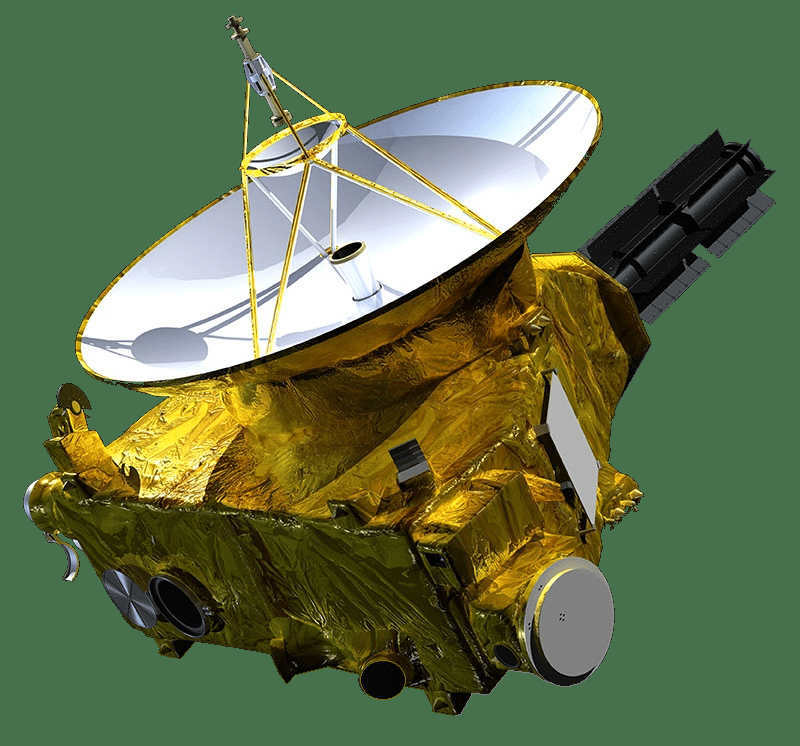
Viking-2 took 333 days to arrive at its destination and its primary objective was to search for signs of life. The apparatus captured over 16 thousand photographs, offering a fresh and vibrant perspective of Mars.
Launched in 1996, Mars Pathfinder successfully landed on the Red Planet after a journey of 183 days. During its mission, the spacecraft extensively studied the local soil.
Mars Express, a space station operated by the European Space Agency, completed its transit in 201 days.
The Mars Reconnaissance Orbiter, the first reconnaissance mission launched in 2005, aimed to identify potential landing sites for future colonists. The journey lasted 210 days.
The Maven spacecraft, which was launched in 2013, was dedicated to the investigation of the atmosphere of Mars and completed its mission in 307 days.
In contrast, the Soviet Union faced numerous challenges and setbacks in their attempts to study Mars, experiencing many failed launches and technical malfunctions during the course of their missions. However, their exploration of Venus proved to be more successful. For instance, the Soviet Mars-1 probe managed to reach Mars in a span of 230 days.
The disparity in the duration of these missions can be attributed to the distinct positions of the two planets in relation to Earth. Additionally, it is important to note that technological advancements do not significantly impact travel time, as the duration primarily relies on intricate mathematical calculations involving the analysis of the orbital paths of these celestial bodies.
What is the distance in kilometers between Earth and Mars?
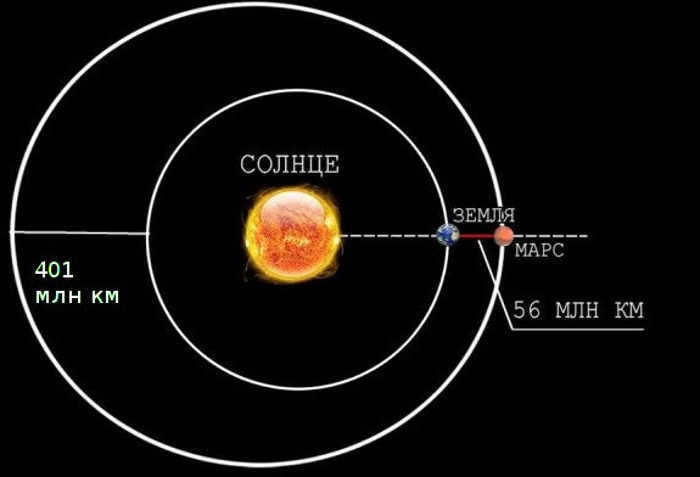
- The maximum separation between the planets Earth and Mars can reach 401 million kilometers.
- On average, the distance between the two planets is approximately 225 million kilometers.
- During its closest approach, Mars can be as close as 54.6 million kilometers to Earth.
If you were to have perfect conditions and the capability to propel a spacecraft with humans on board at the same speed as the fastest vehicle ever launched by humans – “New Horizons”, which reached a speed of 58,000 km/h, it would only take 39 days in a straight path..
How long would it take to travel to Mars at the speed of an airplane?
For instance, if it were possible to undertake interplanetary travel using airplanes, then with the average speed of modern airliners at 1000 km/h, the journey to Mars would take over 22 thousand days.
Flight trajectories
It is important to note that within the solar system, there exist numerous gravitational points, making it impossible to launch objects in a perfectly straight line. It is crucial to minimize the influence of the Sun’s gravitational pull, as it can easily capture and obliterate any object launched from Earth. Consequently, specific flight paths have been devised to facilitate travel to the Red Planet. Multiple primary trajectories exist for reaching Mars.
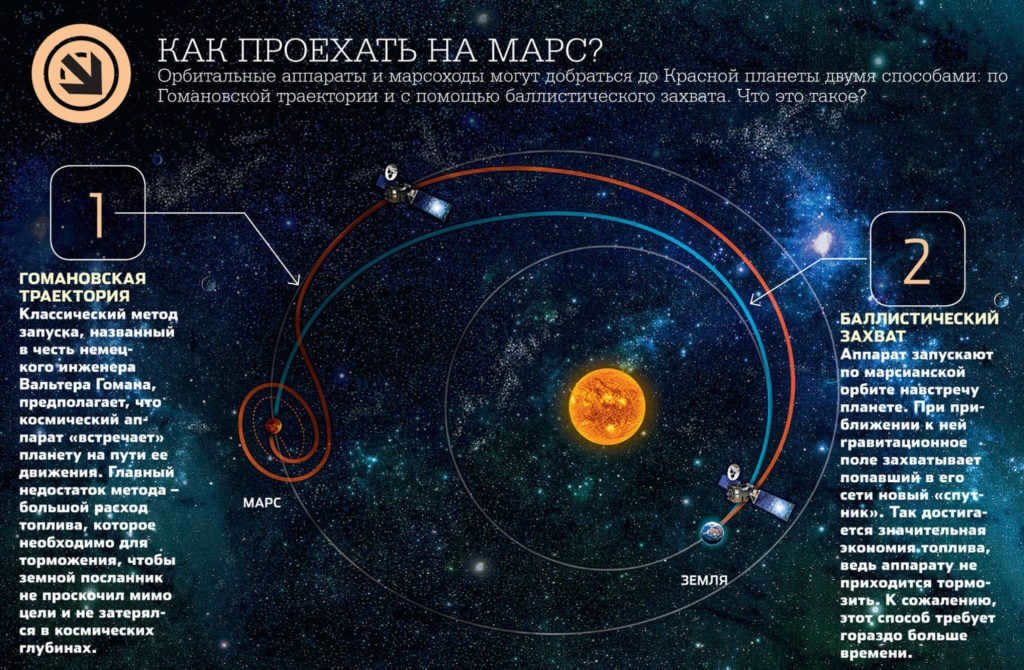
Goman’s trajectory
One approach to reaching a celestial body involves launching an object in the opposite direction of the planet’s motion. This approach, known as Goman’s trajectory, was developed by German engineer Walter Homann. However, a major drawback of this method is that it necessitates a substantial amount of fuel for deceleration.
Ballistic capture
Ballistic capture is a second approach that proposes launching vehicles directly into Mars’ orbit in the opposite direction and relying on atmospheric braking for deceleration. Implementing this method may take longer.
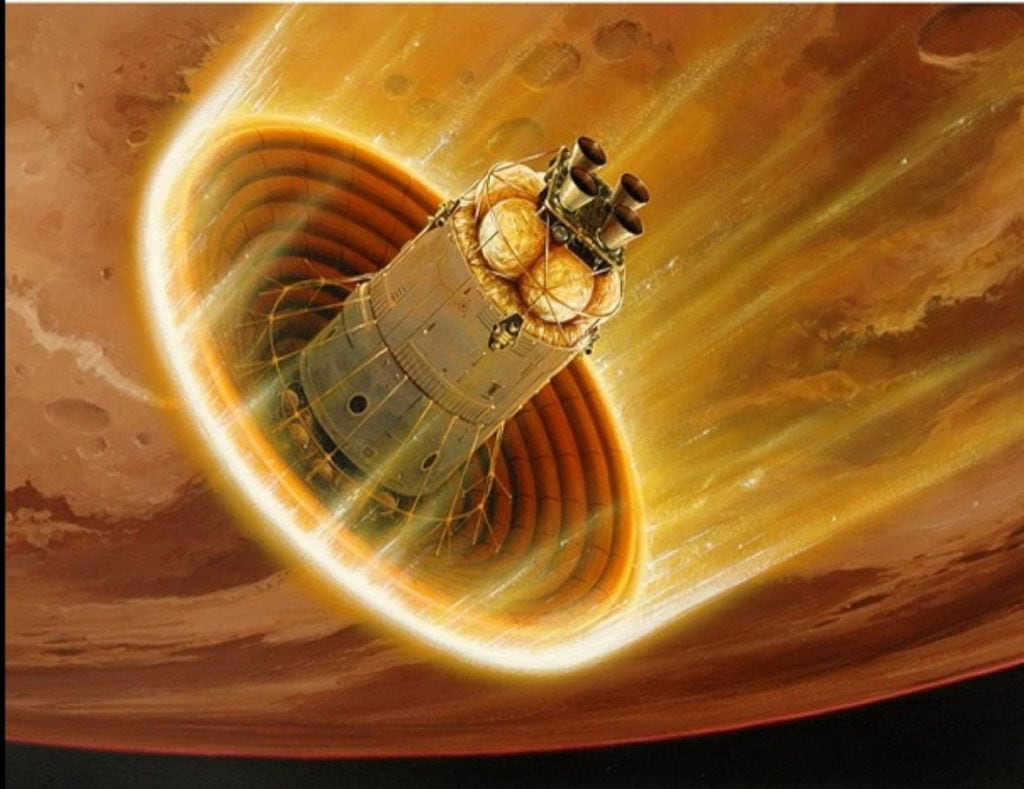
Parabolic Flight Path
The parabolic flight path presents the most complex route, but it can be completed within a mere 80 days. This approach necessitates the spacecraft reaching a velocity of 16.7km/s, which is equivalent to the third cosmic velocity. Executing such a maneuver would demand four times the amount of fuel compared to the initial method. However, due to the significant reduction in travel time, expenses can be minimized when it comes to providing sustenance and life support for the crew.
Round trip mission
The primary challenge faced by the organizers of the inaugural Mars mission is not only to successfully send the spacecraft to a distant location, but also to ensure its safe return. The higher the velocity of the ship, the lower the overall cost of the mission. It is widely acknowledged that a minimum speed of 18 kilometers per second is necessary to accomplish this feat.
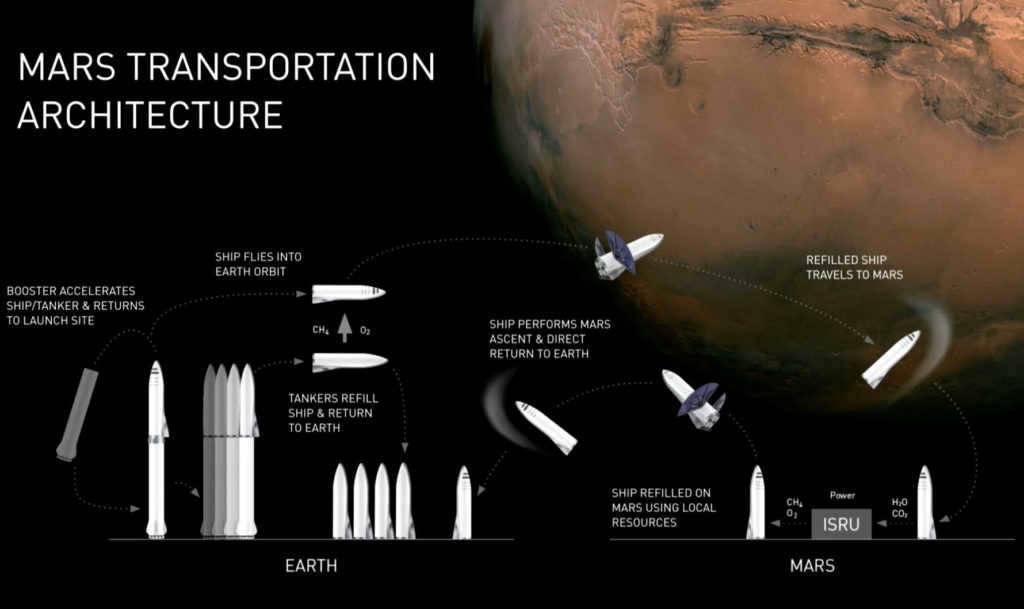
Engineer Robert Zubin proposes the use of nuclear engines for the Mars flight, which would necessitate the spacecraft carrying 6 tons of hydrogen from Earth. For the return journey, carbon dioxide, abundant on Mars, would be utilized. Water can be separated into oxygen and hydrogen, with the latter being converted into methane. These processes would provide the astronauts with the necessary fuel to return home.
Under these circumstances, the journey is estimated to take around 9 months, with an additional 17 months spent in orbit around the Red Planet to align the ideal positioning of the two celestial bodies. It could take up to 500 days for the two planets to come into close proximity to each other.
How much fuel is required for a journey to Mars?
Prior to calculating the fuel quantity, it is crucial to accurately plan out the spacecraft’s route. Mars is in constant motion around the Sun, and engineers must determine the flight trajectory and the planet’s position at the time of arrival. These factors are used to calculate the distance the spacecraft will cover and the necessary amount of fuel.
Space is an incredibly stunning realm, yet it poses infinite dangers to its explorers. Thus far, in the relatively short history of space exploration, civilization has only managed to safeguard astronauts on relatively brief missions, such as staying aboard the International Space Station (ISS) or journeying to the moon. However, scientists are still confronted with more intricate and lengthier missions.
As an illustration, while planning a possible expedition to Mars, NASA has identified five significant risks that astronauts may encounter. To ensure the safety of future interplanetary explorers, NASA is implementing a specialized program dedicated to researching and developing state-of-the-art protection methods and equipment.
Concerns about Radiation
It is common knowledge that excessive exposure to radiation can have severe health implications. However, the levels of harmful radiation experienced on Earth pale in comparison to what astronauts will face on their journey to Mars.
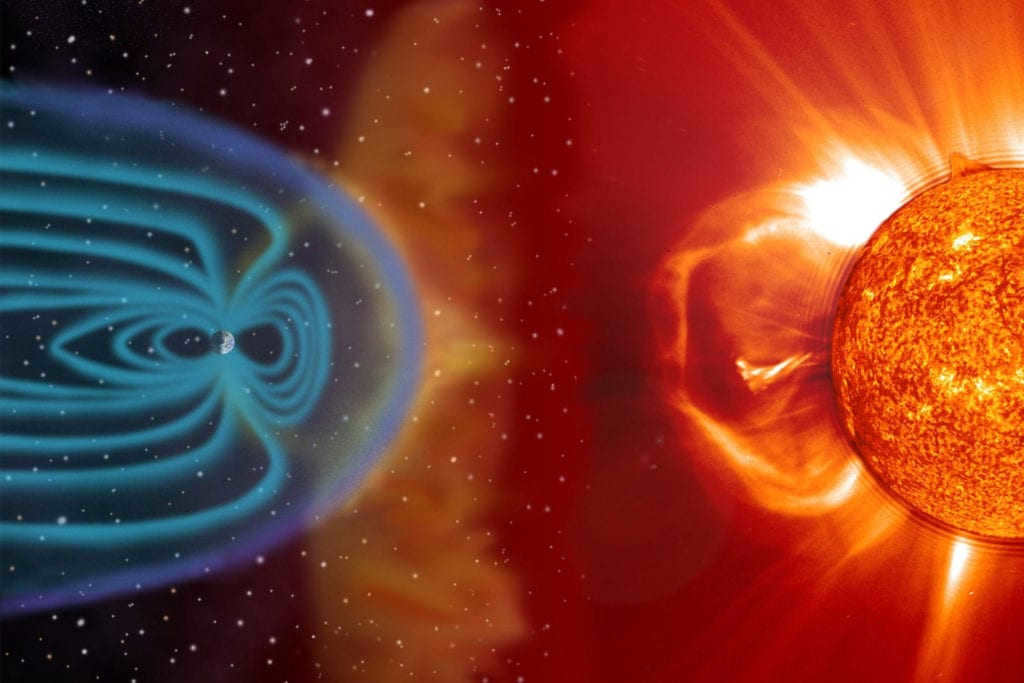
Space radiation poses a significantly greater risk compared to the radiation levels experienced on Earth. Even astronauts aboard the International Space Station (ISS) are exposed to radiation that is 10 times stronger than what is typically encountered on Earth. The Earth’s magnetic field provides a protective barrier against radiation, but the same cannot be said for outer space. The long-term effects of space radiation on humans remain largely unknown and present a major challenge for future interplanetary missions.
Isolation and Confinement
Not all hazards originate from the concealed nooks of the cosmos. The human mind is an extraordinarily delicate apparatus. Experts have been aware for quite some time that extended seclusion leads to fluctuations in mood, disruptions in environmental perception, difficulties in interpersonal communication, and can also bring about severe sleep disorders. According to NASA’s projections, altering individuals’ consciousness is unavoidable during extended stays in a restricted environment. As a result, the selection process for such a journey must be exceedingly stringent.
Distance between Earth and Mars
When astronauts finally reach Mars, they will be venturing further away from Earth than any previous mission. While the Moon is a mere 380 thousand kilometers away, Mars is a staggering 225 million kilometers from our home planet. This vast distance means that the first colonizers will need to be incredibly self-sufficient, as they cannot rely on quick deliveries from Earth. In fact, any signal sent from Mars will take approximately 20 minutes to reach Earth. The scientific community is still debating what supplies and resources will be necessary for the first humans to embark on this monumental journey.
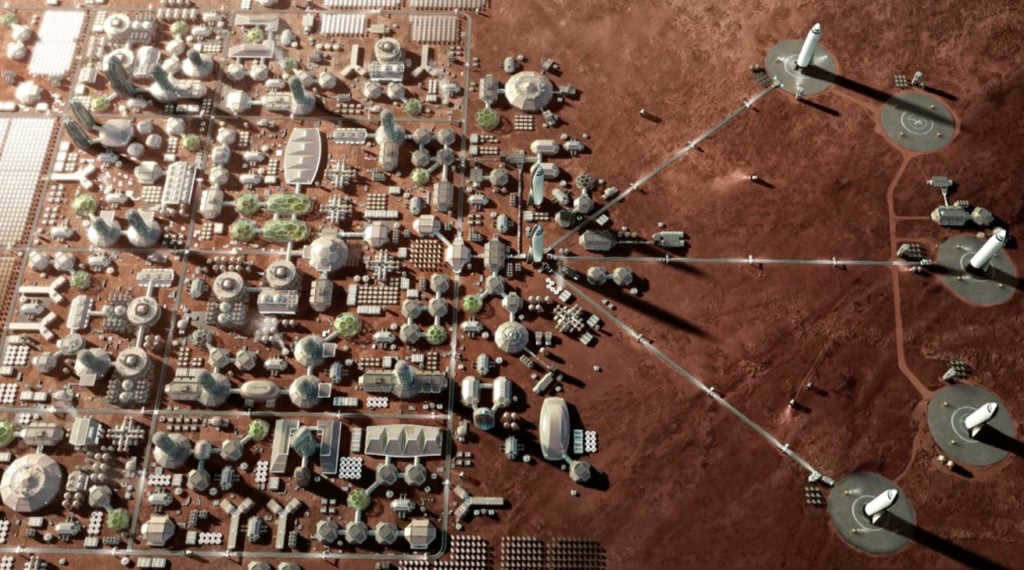
Fields of Gravity in Space Exploration
During the journey to Mars, settlers will encounter three distinct gravitational fields: the gravitational pull of Earth, the near absence of gravity in outer space, and the gravitational force of Mars itself. Ongoing research is being conducted to understand the impact of these gravitational gradients on human well-being.
Challenging Surroundings and Confined Spaces
Based on scientific estimates, the voyage of the initial colonizers to Mars is expected to take approximately 6 months. The space environment is inherently inhospitable, necessitating the need for optimal living conditions and the highest quality spacecraft to ensure the well-being of the crew. As a result, engineers must strive to provide maximum comfort for astronauts and create an environment that fosters positivity and physical activity.
Fascinating fact: Elon Musk, who is the center of attention when it comes to colonizing Mars, stated during a TED conference interview in 2015 that he intends to complete the colonization of this captivating planet by the end of his lifetime. His vision includes the establishment of an entire city on Mars. When asked why he is pursuing this ambitious endeavor, Musk responded, “I’m not attempting to be a savior for humanity, I’m simply contemplating the future and striving to avoid despair.” It’s worth noting that all the promises made by the visionary engineer at this conference have been successfully fulfilled thus far.
To conclude, let us reference the theories of the esteemed Russian scientist Konstantin Eduardovich Tsiolkovsky regarding the key stages of space exploration.

Mars is the most similar planet to Earth in the entire Solar System. Moreover, it is already plausible to travel to Mars at present. Plans to establish colonies on this enigmatic planet are currently being devised and refined. If humanity embarks on the exploration of distant worlds, Mars will undoubtedly be the primary destination, despite the numerous challenges that engineers and scientists encounter.
If you come across any mistakes, please select the erroneous text fragment and press Ctrl+Enter.
Most of the characteristics of the Red Planet conform to the parameters established during the formation of the solar system. Through the study of time, seasonality, and the movement of the planet, human beings continue their quest for signs of life on Mars.
The duration of a day on Mars is slightly longer than that on Earth, and this disparity in time caused numerous inconveniences until it was recognized and designated as a sol.
Perhaps sol will serve as a significant milestone for humanity’s colonization of the planet, and in the distant future, the Martian day (sols) will become the standard unit of time for the planet’s inhabitants.
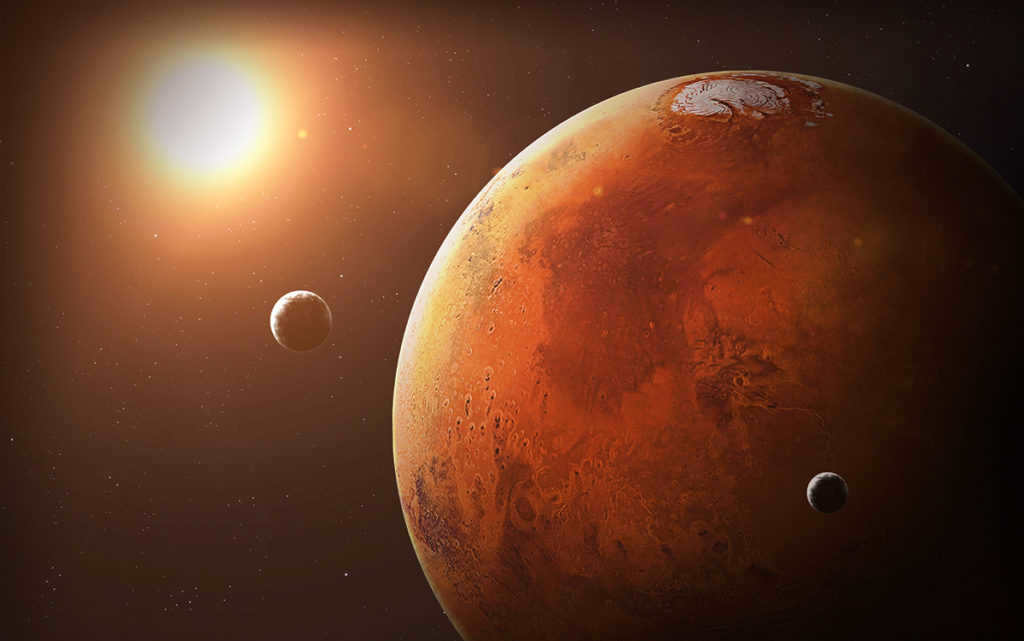
Martian Time
Space stations rely on solar energy for power, which is stored in batteries when the sun is shining. In order to control the vehicles, it is necessary to know the exact amount of radiation the surface receives during each part of the day. Scientists are aware of the length of a Martian day, allowing them to calculate the amount of energy received. However, a day on Mars is longer than a day on Earth, necessitating the use of special time measurement systems.
The Rise of the Martian Sol
What exactly is a Martian sol?
For expeditions to the Red Planet, it is mandatory to adhere to the international standard of using Martian time reference systems.
These Martian days are commonly referred to as sols and are conventionally divided into 24 hours.
It is important to note that this breakdown accounts for the fact that Martian seconds are 2.7% longer than Earth seconds.
Scientists have faced challenges in measuring time while exploring the Red Planet, leading to the emergence of the Martian sol as a unique unit of time measurement.
What caused the sol?
The investigation of the planet is automated, individuals do not travel to the Red Planet independently, but rather send vehicles. In the course of investigating the planet, scientists required more data on solar radiation, which supplies energy to the rovers.
Days on Mars have slight variations compared to Earth’s days, however, the Martian year is significantly distinct from Earth’s. In such circumstances, it became necessary to create a Martian clock and a special calendar that are synchronized with the Red Planet.
The tilt of the rotation axis of the celestial body is not significantly different from Earth’s tilt, the planets undergo similar seasonal changes.
What is the duration of a Martian day?
On Mars, the length of a day is different from Earth’s twenty-four hour day, which is divided into intervals such as seconds, minutes, and days. The division of time on Earth was based on the natural annual and diurnal cycles, with 24 hours representing the time it takes for the Earth to complete one rotation around its axis.
In the field of science, there are two types of days: solar days and stellar days. A solar day is determined by the time it takes for one rotation on its axis. However, due to the elliptical shape of Mars’ orbit, the duration of a solar day is not always equal to 24 hours. To ensure accurate calculations, sidereal days are introduced.
On average, the distance between Earth and Mars is approximately 228 million kilometers, making Mars the closest planet to Earth. As a result, many of Mars’ properties are similar to those of Earth.
– Mars rotates at a speed of approximately 870 km/h at the equator.
The Martian day differs only slightly from Earth’s day. A solar day, known as a Sol, is longer than a sidereal day.
The duration of a day on Mars:
– 24 hours and 37 minutes (sidereal).
– A Sol equals 24 hours and 39 minutes.
– According to solar measurement, the Martian night lasts for 12.2 hours.
The length of a Martian day is 24 hours and 37 minutes, meaning that sunrises and sunsets on Mars are similar to those on Earth. However, the color schemes of sunsets and dawns on Mars are completely different due to the following factors:
– The distance between Mars and the Sun.
– The presence of dust in Mars’ atmosphere.
Dust is responsible for absorbing blue wavelengths, which gives Mars its distinctive warm color palette that humans are familiar with. During dawn, the sky takes on a blue hue, but once the Sun rises, the dust once again absorbs the blue light, leaving only warm colors visible to the human eye.
How long is a year on Mars?
On Earth, we measure a year in two ways:
– Stellar year.
– Solar year.
A solar year represents the Earth’s complete revolution around the Sun.
A sidereal year, on the other hand, is the orbital period relative to fixed stars.
The difference between these two measurements is approximately 20 minutes.
Mars also has two types of years, each with its own length.
The rotation speed of Mars is slower than that of Earth, resulting in a longer duration of a Martian year. On Earth, a year consists of 686 days, while on Mars, it lasts for 668 sols. The seasons on Mars are defined by the time intervals between the equinox and solstice. The longest spring on Mars lasts for 193 sols, while fall lasts for 142 sols.
The beginning of the solar year on Mars is marked by the day of the equinox. This choice is made because the Martian orbit has an elongated, elliptical shape, and using other days as reference points would yield different results. Mars rotates around its axis at an inclination of 25 degrees.
– Spring on Mars lasts for 7-6 months.
– Summer and fall combined span a duration of 5 months on the Red Planet.
– The winter season on Mars has a duration of approximately 4 months.
What is the length of a Martian year?
– A Martian year is equivalent to about 687 earth days or 669 sols.
– A Martian day lasts for 24 hours and 37 minutes.
– The Red Planet completes one revolution around the Sun in 1.88 Earth years.
Martian calendar
A Martian calendar is being predicted by scientists for use in human missions to Mars. However, its development is facing several challenges:
– Currently, it is impossible to determine the time cycles on the planet, such as the month and year.
– Synchronizing Earth’s cycles with Mars’ periods is proving to be difficult.
One proposed solution is to utilize leap days to adjust the number of days between the two planets. In practice, the sol is the primary unit of time measurement. The year holds astronomical significance.
The path of Mars
The time when Mars is closest to Earth is known as an opposition, a occurrence in which the planet is situated in the opposite direction from the Sun.
– The opposition happens once every 26 months at different locations in the Earth’s and Martian orbits.
– Every 15 years, Mars reaches the perihelion point, the spot of the Red Planet’s closest approach to the Sun.
– This event is referred to as the Great Opposition.
– The planet achieves its highest brightness and largest angular size.
– It takes approximately 12 minutes for light to travel from the Sun to Mars at the speed of light.
1. The closest distance to the Sun is 1.52 light-years or 55.67 million kilometers.
2. The farthest distance at aphelion is 401 million kilometers.
3. On average, the Sun and Mars are separated by 228 million kilometers or 1.52 light-years.
Mars’ Movement
Humans can observe Mars without a telescope. When it is at its closest point to the Sun, the planet becomes very bright, second only to the Sun and the Moon in luminosity. By carefully studying the movement of this celestial body, one can notice that Mars changes its direction of motion in space. It is important to understand that the planet does not actually move backwards, but rather the backward motion effect is caused by:
– The difference in velocity between Earth and Mars.
– The distance of Mars’ orbit from the Sun in relation to Earth’s orbit.
When Mars orbits around the Sun, there is a phenomenon known as retrograde motion, which creates a perception of the planet moving backwards when observed from Earth.
Mars’ Orbital Velocity
Orbital velocity refers to the speed at which a planet revolves around the sun. On average, Mars has an orbital velocity of 24 fps.
Space velocity, on the other hand, is a measure of an object’s motion within the gravitational field of a celestial body. It represents the minimum speed that a spacecraft must achieve in order to accomplish its objectives in the absence of an atmosphere.
Space velocity can be calculated at any distance from Earth.
The minimum value required by an object to pass the gravitational field is known as the second space velocity. In the case of Mars, its second space velocity is 5km/s. This velocity is necessary for an object to overcome the gravitational pull of the planet. The mass of the apparatus is usually neglected due to its small size compared to the mass of the planet.
The rotational period of Mars
Mars has a period of revolution that is twice as long as that of Earth. This means that it takes Mars twice as long to complete one revolution around the Sun compared to Earth.
– The period of revolution around the Sun for Mars is equal to 1.88 revolutions of Earth.
– This measurement is based on the planet’s position relative to the stars and is known as the sidereal period.
– The sidereal period of Mars is equal to 2.135.
Mars follows an elliptical orbit around the Sun, which is 1.5 times farther from the Sun compared to Earth’s orbit. It has been determined that more than a million years ago, Mars had a circular orbit.
– When the Red Planet is closest to the Sun, at perihelion, its orbital radius is about 207 million kilometers.
– At its farthest distance from the Sun, at aphelion, the radius is 250 million kilometers.
– The planet’s extensive travels result in a significant temperature fluctuation each year.
– Mars has a greater orbital radius than Earth due to its distance from the Sun.
– The orbit’s large semi-major axis, which is its longest diameter, spans 1.5 light years.
Rotation of the Axis
Mars not only orbits the Sun, but also undergoes rotation around its axis.
– The speed at which Mars rotates around its axis is 869 km/h.
– This rotation is responsible for the variation in the length of the Martian day and the flattening of the planet’s poles due to centrifugal force.
– The position of the polar axis shifts due to the gravitational influence of the Sun.
– Additionally, the gravitational force exerted by Jupiter impacts the tilt of Mars’ axis.
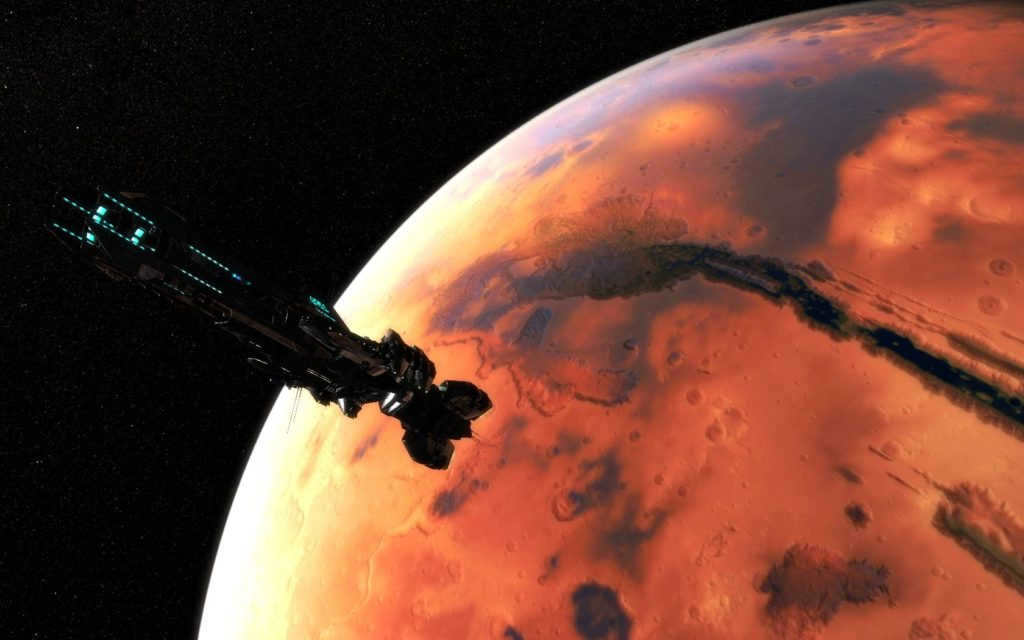
With the goal of finding evidence of extraterrestrial life, the focus of exploration has shifted towards Mars. This shift is driven by the planet’s close proximity to Earth and its similarities to our own planet. Experiments conducted on Earth, simulating Martian conditions, have shown that certain organisms such as extremophile bacteria, blue-green algae, and lichens can thrive in this environment. However, despite the efforts of rovers sent to Mars, no signs of life have been detected. This discrepancy has sparked new inquiries into the possibility of human survival on Mars and the duration of a potential journey to the planet.
What is the duration of a flight from Earth to Mars?
Estimating the exact duration of a flight from Earth to Mars is not possible, as it depends on several factors:
- The chosen flight path.
- The speed of the spacecraft.
- The weight of the ship and its cargo.
By considering the estimated speed and flight path, you can approximately calculate the flight time. The fastest spacecraft ever launched into space traveled at a speed of 58,000 km/h.
However, this particular spacecraft, named New Horizons, reached the orbit of Mars in 78 days but was relatively light as it did not carry heavy instruments.
A fully loaded ship, including instruments and crew, would be considerably heavier. Therefore, it is more realistic to use the average speed of space rockets, which is around 20,000 km/h, for calculations.
It appears that the most efficient route would be a straight path. However, due to the planets’ continuous orbit around the Sun, it is impossible to reach Mars on such a trajectory. By flying to Mars on an elliptical path, the spacecraft will arrive at the Red Planet in approximately 289 days.
How far does light travel to reach Mars?
In order to calculate the average travel time to Mars, we need to know the average distance between Mars and the Sun (228 million km) and the speed of light in a vacuum (300 thousand km/s).
By using these values, we can determine that it takes an average of 760 seconds, or 12 minutes, for light to reach the Red Planet. When Mars is closest to the Sun (perihelion), this time is reduced to 11 minutes, and when Mars is farthest from the Sun (aphelion), it takes 13.01 minutes.
The distance between Mars and Earth can vary depending on their relative positions. When the Sun is positioned between them, the distance reaches its maximum of approximately 401 million kilometers. Conversely, when Earth is located between Mars and the Sun, the distance is at its minimum of about 55.75 million kilometers.
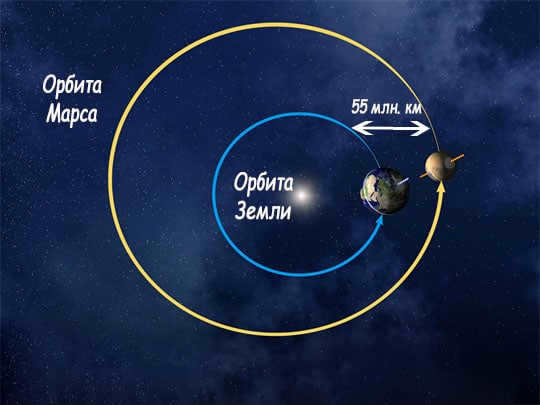
Purposes of a mission to Mars
The primary goals of a human expedition to Mars include:
1. Establishing a colony.
Given the extensive duration of the journey, establishing a colony is the most viable approach for directly exploring the Red Planet. Furthermore, despite its harsh conditions, a Mars mission will provide scientists with insights on the possibility of human survival in such an environment.
2. Conducting exploration.
– Searching for extraterrestrial life forms.
The striking similarities between Earth and Mars have led scientists to speculate the existence of life on the Red Planet. Although rovers have not discovered any living organisms on Mars, areas with elevated methane concentrations, a carbon source for protein-based life forms, have been identified. Consequently, scientists remain hopeful in their quest to uncover potential microorganisms on Mars.
– Investigating valuable geological resources.
The Martian lava is believed to contain significant reserves of non-ferrous metals such as nickel and copper, as well as precious platinum group metals;
– Examining the natural conditions, soil composition, and other characteristics of Mars.
Possible routes to Mars
Scientists have devised three trajectories, each with varying flight durations and speeds:
1. Elliptical, which offers the easiest and least energy-intensive journey but takes the longest time.
2. Parabolic.
3. Hyperbolic, which requires high energy expenditure for a faster arrival at the Martian surface.
Elliptical Path
The elliptical path is also known as the “Goman” trajectory, named after the German scientist Walter Goman, who first formulated it. In addition to Goman, Soviet scientists Friedrich Zander and Vladimir Vetchinkin also independently proposed this path.
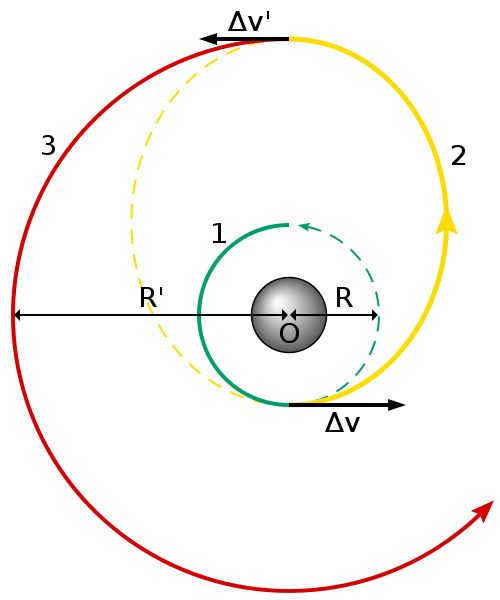
The most efficient way to travel to Mars is by following an elliptical trajectory, which requires the least amount of fuel. This trajectory represents half of the elliptical orbit around the Sun. During this journey, Earth is positioned at the closest point to the Sun (pericenter), while the most distant point from the Sun (apocenter) is near Mars.
In order to launch a spacecraft, it is crucial to select the most favorable period of time. Through mathematical calculations, it is possible to determine the optimal launch window so that the spacecraft aligns with the arrival point on Mars’ orbit. These launch “windows” occur every 2 years and 50 days.
Back in 1969, the Red Planet witnessed its quickest flight when the Mariner 6 spacecraft successfully arrived in just 131 days. On the other hand, the longest rocket flights, such as the Mars Observer, Mars Polar Lander, and Viking-2, endured for more than 330 days.
Considering the necessity of windows in the trajectory, if a crew were to embark on a journey to Mars, they would have to spend 450 days on the planet, waiting for the next window. Consequently, a round trip to Mars would amount to a total duration of 2 years and 8 months.
Parabolic path
A parabolic trajectory is a curved path that has the shape of a parabola. If a spacecraft is launched along this trajectory, it will be able to reach Mars in a span of 70 days.
However, when compared to an elliptical path, a parabolic trajectory requires a significant amount of energy (fuel costs increase by a factor of 4.3).
This is primarily due to the substantial fuel consumption during launch and landing. To follow a parabolic trajectory, the spacecraft needs to accelerate to a speed of 16.7 km/s (the third cosmic velocity) and then decelerate upon landing (reaching a speed of 20.9 km/s). Despite the high energy requirements, a journey to Mars along a parabolic path would take approximately 5 months.

Hyperbolic path
When following a hyperbolic path, the spacecraft will need to bypass the planet and then alter its course by entering its gravitational field.
The velocity of the spacecraft must exceed the third cosmic velocity, meaning it will need to be greater than 16.7 km/s.
Humanity has already launched spacecraft at such high velocities, such as New Horizons and Pioneer-10. This method of reaching Mars is the most costly in terms of energy requirements.
A spacecraft with a chemical propulsion system will be unable to follow this trajectory to Mars. What is required is a swift rocket with a more efficient engine capable of accelerating it to and beyond the third cosmic velocity at lower energy costs, such as a nuclear or electric engine.
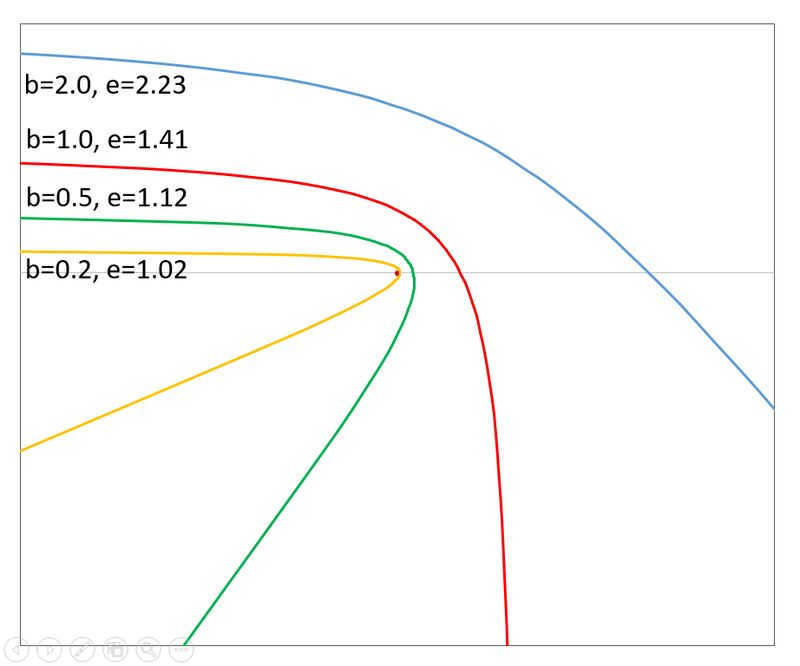
Anticipated Schedule for the First Human Mission to Mars
Roscosmos, NASA (USA), and ESA (Europe) are all planning to send spacecraft to our neighboring planet. Despite the success of the international 500-day experiment known as “Mars-500,” the leaders of these space agencies have yet to announce a specific date for the mission.
It is currently projected that the first journey to Mars will not occur before 2025.
Not only space agencies from different countries, but also private companies are involved in the preparations for the flight. Mars One aims to land the first humans on the planet by 2027. Space X plans to send a human to Mars in 2024. The Marshall Space Flight Research Center is also working towards landing humans on Mars by 2024. Ames is currently developing a project to send humans to Mars by 2030, with no plans of returning to Earth.
Roscosmos, NASA, and ESA, three space agencies, have all declared their goal of traveling to Mars in the 21st century. Other countries have not yet developed plans to fly to Mars due to the underdevelopment of their space industry.
Some countries have completely abandoned the idea of flying to Mars. The UAE Council on Religion has strongly spoken out against flights to the Red Planet, considering it a form of suicide, and has banned its citizens from traveling to Mars.
Similar to other Earth inhabitants, Russians have yet to set foot on Mars. However, Russian scientists are actively preparing for the mission. In 2012, a collaboration between Russia and Kazakhstan was announced to construct and launch a super-heavy rocket destined for Mars. This rocket, named Sodruzhestvo, is designed to be both energy efficient and capable of carrying a substantial payload.
The Sodruzhestvo rocket will be powered by a combination of nuclear fuel and solar batteries, allowing it to transport up to 65 tons of cargo. Currently, Rosatom is working alongside Roscosmos to develop a nuclear electric motor, with completion expected in 2023. Once this motor is finalized, the first Russian cosmonauts will have the opportunity to embark on a journey to Mars.
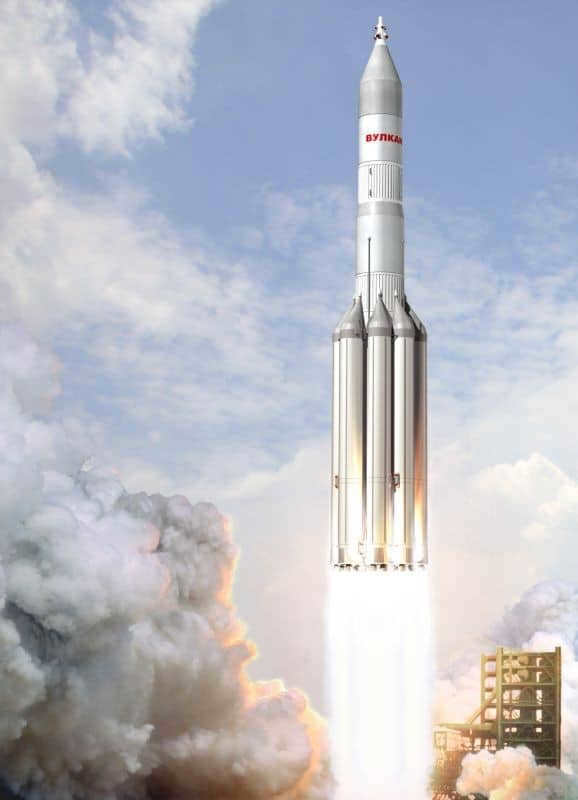
America’s aspirations
The initial proposals for a Mars expedition were put forward during George W. Bush’s presidency, but due to the exorbitant financial costs involved, they were unable to come to fruition.
In 2015, NASA devised a fresh strategy for venturing to Mars.
This strategy encompasses several key phases:
1. The extraction of valuable resources from the Moon, such as fuel, oxygen, water, and construction materials. These supplies will then be transported to Mars’ orbit using ion tractors.
2. The colonization of Mars, utilizing its own resources. As an alternative approach, a mini-base could be established not on the planet itself, but on one of its moons – Phobos or Deimos. The astronauts would spend a year there before returning to Earth.
In late 2015, NASA commenced efforts to identify a suitable landing site for astronauts on the Red Planet.
Plans of the European Space Agency
The European Space Agency has formulated a plan called Aurora, which encompasses manned space expeditions to both Mars and the Moon. It is anticipated that the initial voyage to Mars will occur in the year 2033.
Endeavors undertaken by private entities
Several private organizations have set their sights on a prospective mission to Mars.
1. The Mars One initiative, spearheaded by Bas Lansdorp, aims to execute a mission to the Red Planet and establish a colony there. Additionally, there is a vision to broadcast the daily lives of the inaugural settlers. Mars One is supported by Gerard Hooft, who is a laureate of the Nobel Prize in Physics.
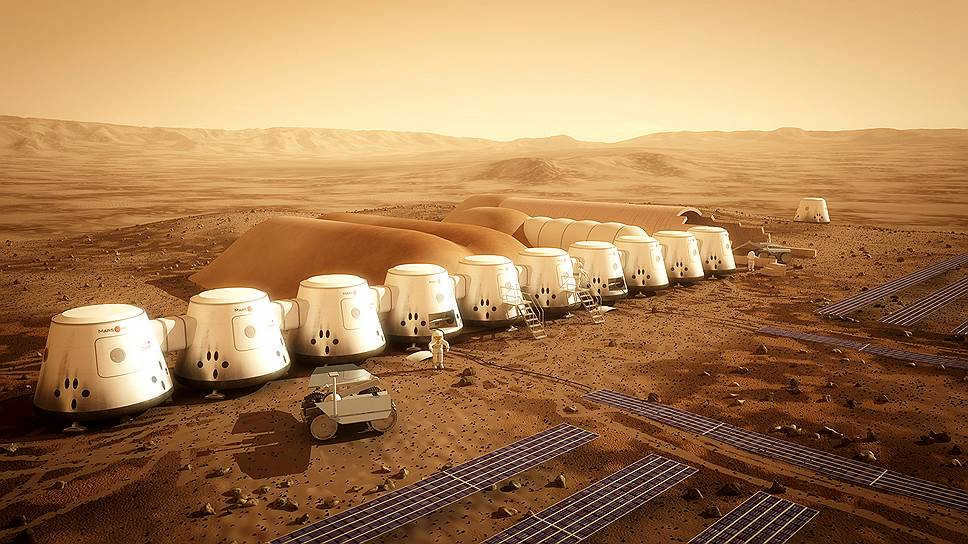
2. Originally, Elon Musk, the CEO of SpaceX, had initially planned to construct a small greenhouse on the Red Planet with the aim of cultivating plants as part of the Mars Oasis project. However, due to the absence of more energy-efficient rockets, the Mars Oasis initiative was ultimately abandoned.
Musk established SpaceX, an aerospace company with the goal of transporting humans to Mars. As the mission is being prepared, the necessary structural components for the future base will be transported to the planet, and by 2024, the first Martians will touch down.
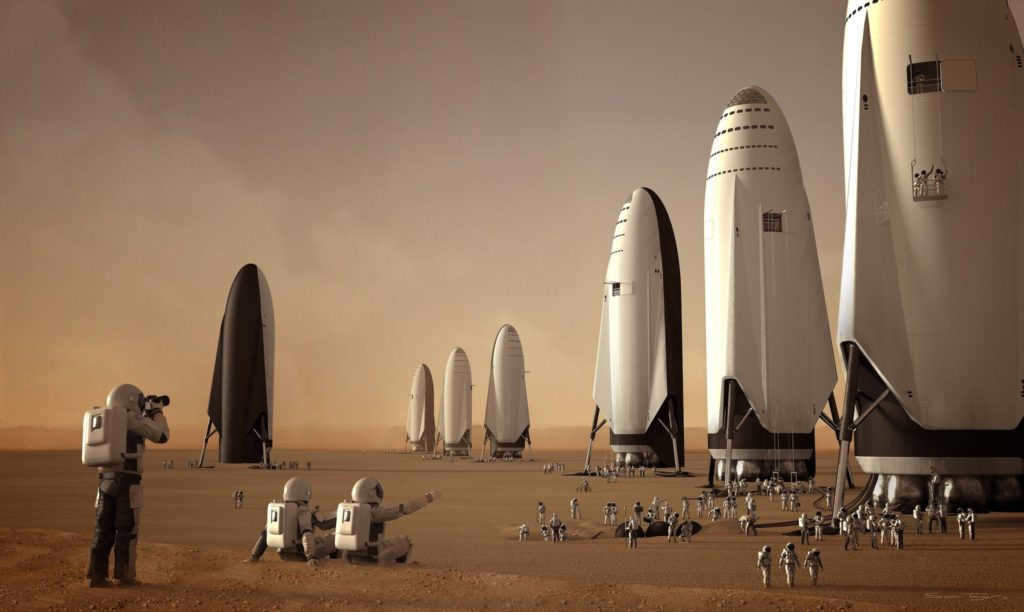
3. The Ames Research Institute is currently working on a project that involves sending humans on a one-way trip to Mars in order to establish a colony by the year 2030.
According to scientists, this one-way flight would require less resources compared to a round trip, allowing the spacecraft to carry more cargo and individuals.
The first settlers on Mars will be responsible for producing oxygen, food, and water using advanced technology and a small nuclear reactor. Every two years, when Mars aligns with Earth in its orbit, NASA will send additional ships with new astronauts.
What is the fuel requirement for a mission to Mars?
A mission to Mars necessitates a significant quantity of fuel, approximately 1630 tons. This is predominantly because of the utilization of energy-intensive chemical engines in spacecraft.
These rockets accelerate to high velocities but necessitate a substantial amount of chemical energy that is released during the combustion of the propellant mixture. Launching and landing on Mars consumes a substantial amount of fuel. Furthermore, the greater the spacecraft’s mass, the more energy is required.
Promising space fuels
Currently, chemical rocket engines rely on a combination of asymmetric dimethylhydrazine and nitrogen tetraoxide as their propellant. However, due to the large quantities of this fuel required for a Mars mission, researchers are working on developing more efficient engines and fuels.
In Russia, a thermal nuclear plant has been developed that harnesses the power of atom splitting to generate thermal energy for jet propulsion.
Every nation is competing to be the first to send humans to Mars ahead of the rest. However, efforts to launch an expedition to the Red Planet have yet to materialize. The current limitations of scientific technology prevent us from realizing a manned mission and establishing the first human settlement on Mars. Nevertheless, this is a matter of the relatively near future…
The journey to Mars for human beings represents one of the most arduous and lengthy undertakings in history. The need to traverse vast distances, the risks of radiation exposure, and the constraints of limited fuel supplies all contribute to making this mission a formidable test for the global scientific and engineering communities. Yet, how long will it ultimately take to reach Mars?
First and foremost, it is important to acknowledge that the distance between Earth and Mars is in a constant state of flux due to the orbital dynamics of the two planets. On average, Mars is situated approximately 225 million kilometers away from Earth. The duration it takes to cover this distance can vary depending on the specific orbit and mode of transportation chosen for the journey.
Nevertheless, even under the most favorable conditions, a trip to Mars would still require several months of travel time. Currently, the quickest route takes around 6-9 months to complete. The primary factor contributing to the extended duration of the flight is the necessity to align the spacecraft’s trajectory with Mars’ orbit through a ballistic landing. This entails launching the spacecraft in a manner that enables it to intersect with the point where the Earth and Mars orbits converge, an event that occurs approximately once every two years.
Therefore, the duration of the journey from Earth to Mars can vary depending on the trajectory and speed of the spacecraft, taking several months. However, once the spacecraft reaches its destination, the next challenge is ensuring a successful landing on the Martian surface. This task necessitates further research and development, which experts are currently undertaking.
Traveling to Mars: The Challenges of Takeoff, Landing, and Survival on the Red Planet
The journey to Mars presents numerous challenges, particularly when it comes to takeoff and landing. These critical phases of the mission require careful consideration of various factors, such as fuel requirements and the duration of the flight. Furthermore, once on the Martian surface, astronauts must be prepared to face the inherent dangers that come with exploring an alien world.
The distance between Earth and Mars is approximately 225 million kilometers, which means that the journey takes around 7-9 months. During this time, the spacecraft must carry enough fuel not only for the outbound trip but also for the return journey back to Earth. Additionally, the communication lag between the two planets adds an extra challenge, with signals taking approximately 3 minutes and 28.699 seconds to travel between Earth and Mars.
Living on Mars also presents specific dangers. The planet boasts an atmosphere primarily consisting of carbon dioxide, rendering it inhospitable to humans without specialized apparatus. Furthermore, the planet’s terrain is abundant with boulders and volcanic peaks, posing risks to explorers. Nonetheless, residing on Mars offers unparalleled opportunities for a multitude of scientific investigations.
What is the distance to Mars in kilometers
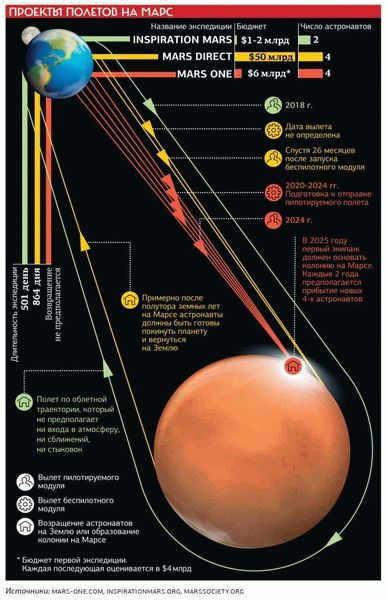
When it comes to traveling to Mars, the distance that needs to be covered is quite substantial. Hence, the question arises: how many kilometers do we have to travel to reach this captivating red planet? To find the answer, one must take into account the flight path and the variations in Mars’ orbit.
Throughout their journey around the Sun, the distance between Earth and Mars can range from 54.6 to 401 million kilometers. On average, the distance between our planet and Mars is approximately 225 million kilometers.
In order to reach Mars, astronauts must embark on a space mission using a spacecraft specifically designed for interplanetary travel. This endeavor necessitates a substantial amount of fuel and a prolonged duration in outer space.
The most challenging parts of a mission to Mars are the takeoff and landing phases. These stages put a significant amount of stress on the spacecraft and require extensive labor and resources.
The length of a journey to Mars is influenced by multiple factors, including the technical capabilities and efficiency of the spacecraft. Currently, the quickest expeditions to the red planet take approximately 9 months.
Travelers encounter various obstacles on their way to Mars, such as radiation exposure, limited access to resources, and prolonged periods without sunlight. This necessitates the use of specialized life support systems and meticulous mission planning.
Risks Associated with Traveling to Mars
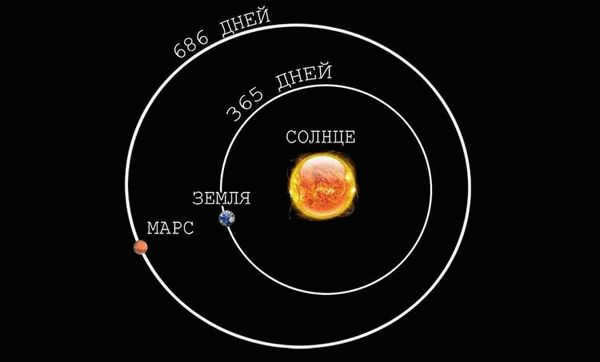
Embarking on a voyage from Earth to Mars is a lengthy and perilous expedition. The distance that light must traverse before reaching the Red Planet is approximately 225 million kilometers. However, the duration of the journey to Mars depends on the spacecraft’s speed, which typically travels at a rate of around 30,000 kilometers per hour.
At this velocity, excluding takeoff and landing, the trip to Mars lasts approximately 7-8 months. Yet, the travel time is only part of the equation; the duration of stay on Mars must also be considered. A successful journey to Mars necessitates careful planning for factors such as sustenance, life support, and crew operations throughout an extended period.
Related article: Overview of the tax exemption provisions for real estate sales under Article 217.1 of the Russian Federation Tax Code in 2023.
However, the primary concern lies in the level of peril associated with a Martian expedition. The journey to Mars poses numerous risks that cannot be underestimated. Firstly, the actual flight itself presents a significant challenge to the human body. One must take into consideration the potential effects of cosmic radiation and the unfamiliar experience of weightlessness. Furthermore, there exists the possibility of sustaining injuries and encountering health issues during the prolonged space travel.
Secondly, a successful journey to Mars necessitates meticulous planning regarding the amount of fuel required for the entire voyage. This constraint limits the scope of further exploration and the duration of the stay on Mars, as the finite fuel supply may lead to an untimely return to Earth.
Consequently, embarking on a Martian expedition demands not only substantial time and resources, but also entails grave hazards. Without adequate training and technological capabilities, a prolonged stay on Mars may prove to be unattainable for humans, ultimately jeopardizing their well-being and even their lives.
What is the distance covered by light on its journey to Mars?
The distance between Earth and Mars is not constant and varies depending on the positions of the planets during the mission. On average, this distance is approximately 225 million kilometers.
In addition to distance, the duration of time spent on the planet is also a crucial factor to consider for a mission to Mars. Typically, these missions last around 6-9 months, including both the round trip time and the time spent exploring the planet.
Traveling to Mars necessitates a substantial amount of fuel, with takeoff and landing being the most perilous aspects of the journey. To ensure a successful mission to Mars, specialized systems must be developed and implemented in order to guarantee the safety of the astronauts.
When light travels to Mars, it takes approximately 15 minutes during the planet’s least favorable position. This implies that if we were able to observe events on Mars in real-time, there would be a slight delay in their display.
Therefore, the amount of light traveling to Mars is not influenced by the speed of human flight, as the propagation of light is constrained by its own speed.
Travelling to Mars necessitates an enormous quantity of fuel. The journey to the crimson planet involves an extensive spacecraft voyage, with the primary peril being that the voyager is in comparative seclusion beyond Earth’s typical atmosphere and illumination.
What is the amount of fuel required for liftoff from Earth? Launching a spacecraft from Earth resolves the issue related to gravity, as well as the necessity for a substantial quantity of fuel to surmount the atmosphere. Attaining the necessary velocity necessitates a considerable amount of fuel and energy, roughly 15 million kilograms of light-years!
An extended sojourn on Mars also necessitates a fuel reserve. Considering that a journey to Mars would take approximately 9 months, a Martian landing, including descent to the surface and return, would necessitate around 20 million kilograms of fuel.
It is important to bear in mind that Mars lacks sufficient resources for extracting fuel. As a result, careful planning is required for all necessary supplies in advance.
When it comes to traveling to Mars, a substantial quantity of fuel is required. The key consideration is ensuring that the team of astronauts has ample resources and fuel reserves to sustain themselves and successfully return to Earth.
What is the duration of a flight to Mars?
The journey to Mars is a significant and protracted event in the annals of space exploration. Embarking on a voyage to the Crimson Planet entails not only the process of takeoff and landing, but also an extensive sojourn in outer space. How much time does it require to travel to Mars?
The gap separating Earth and Mars is estimated to be around 225 million kilometers. On average, light traverses about 300,000 kilometers per second on Earth. Consequently, it would take travelers approximately 15 minutes for light to reach our neighboring planet if they were to fly to Mars.
Nevertheless, a celestial body with a mass greater than that of a photon of light necessitates a significantly longer duration and a greater amount of fuel. In order to orchestrate a mission, astronauts must successfully launch from Earth and navigate their way to the Martian atmosphere for landing. Moreover, on Mars, they must factor in the duration of their stay and all the requisite safety measures in order to ensure a safe return to Earth.
Overall, experts predict that a journey to Mars could last approximately 7-9 months in one direction, depending on the chosen route and propulsion methods utilized. The extended duration of this expedition presents significant challenges, necessitating the deployment of resilient and dependable space technology as well as the capabilities of the crew.
Consequently, embarking on a mission to Mars represents a formidable and extensive endeavor that demands ample time and the careful assessment of numerous factors pertaining to crew safety and the successful execution of the mission.

